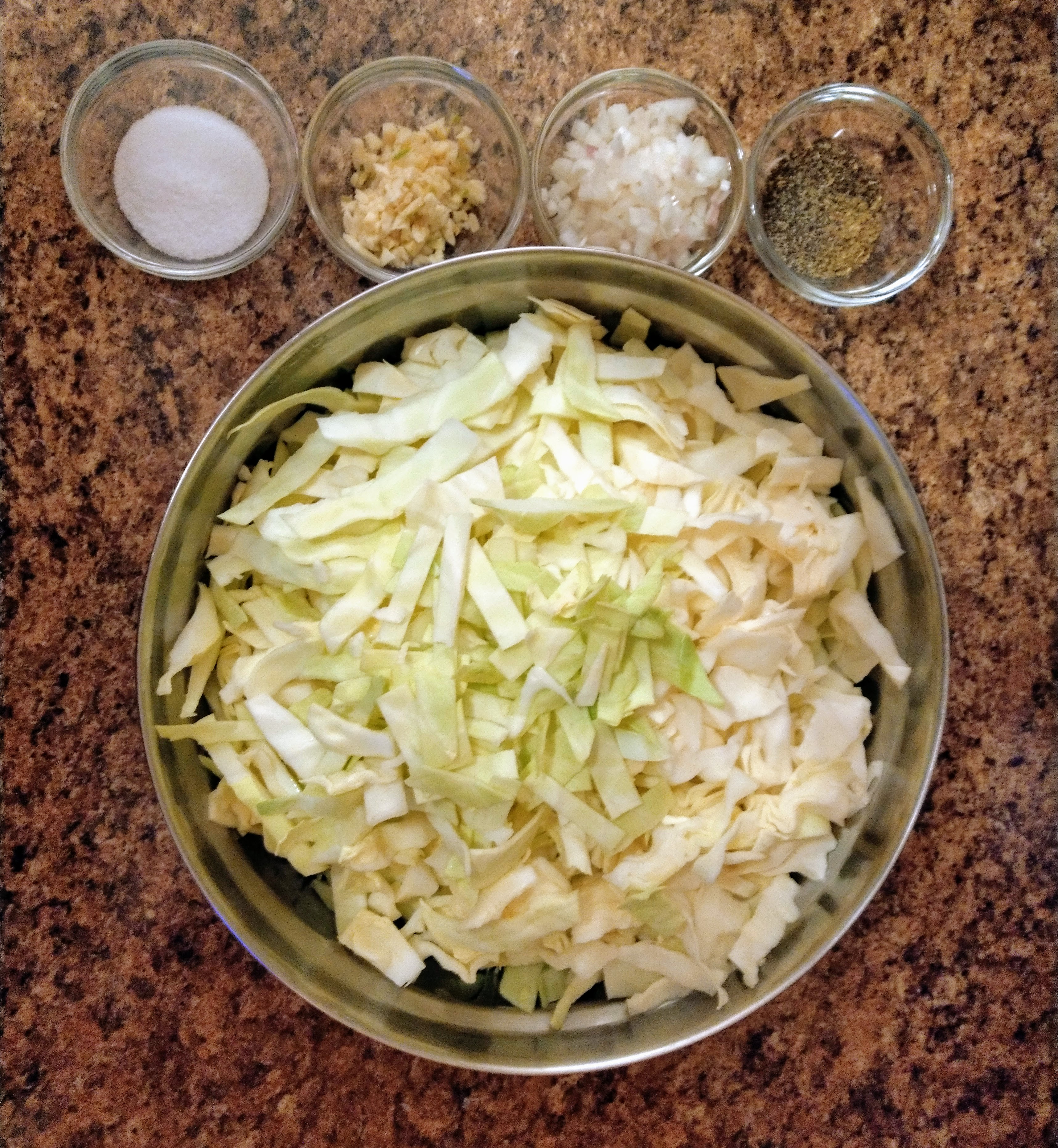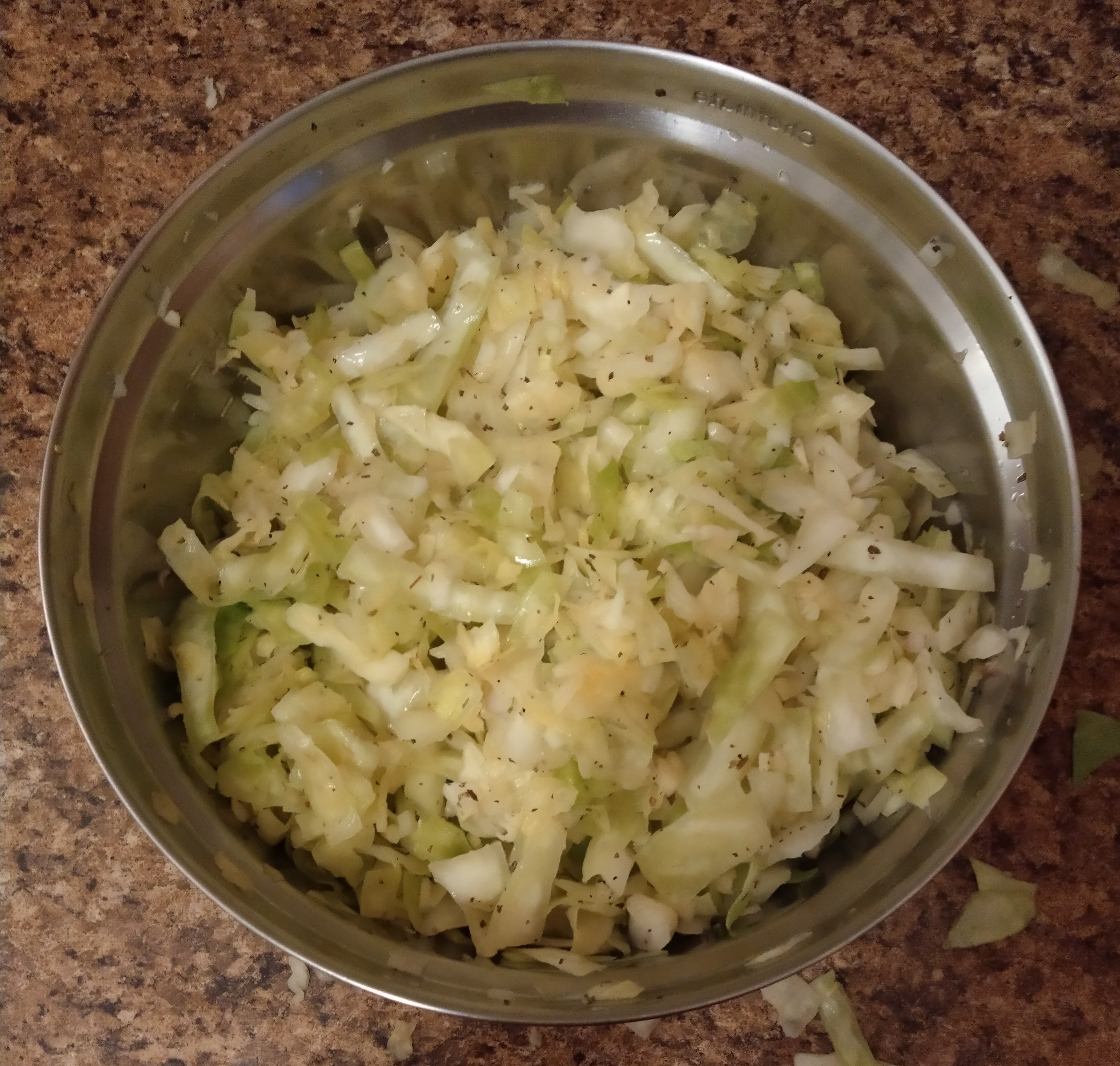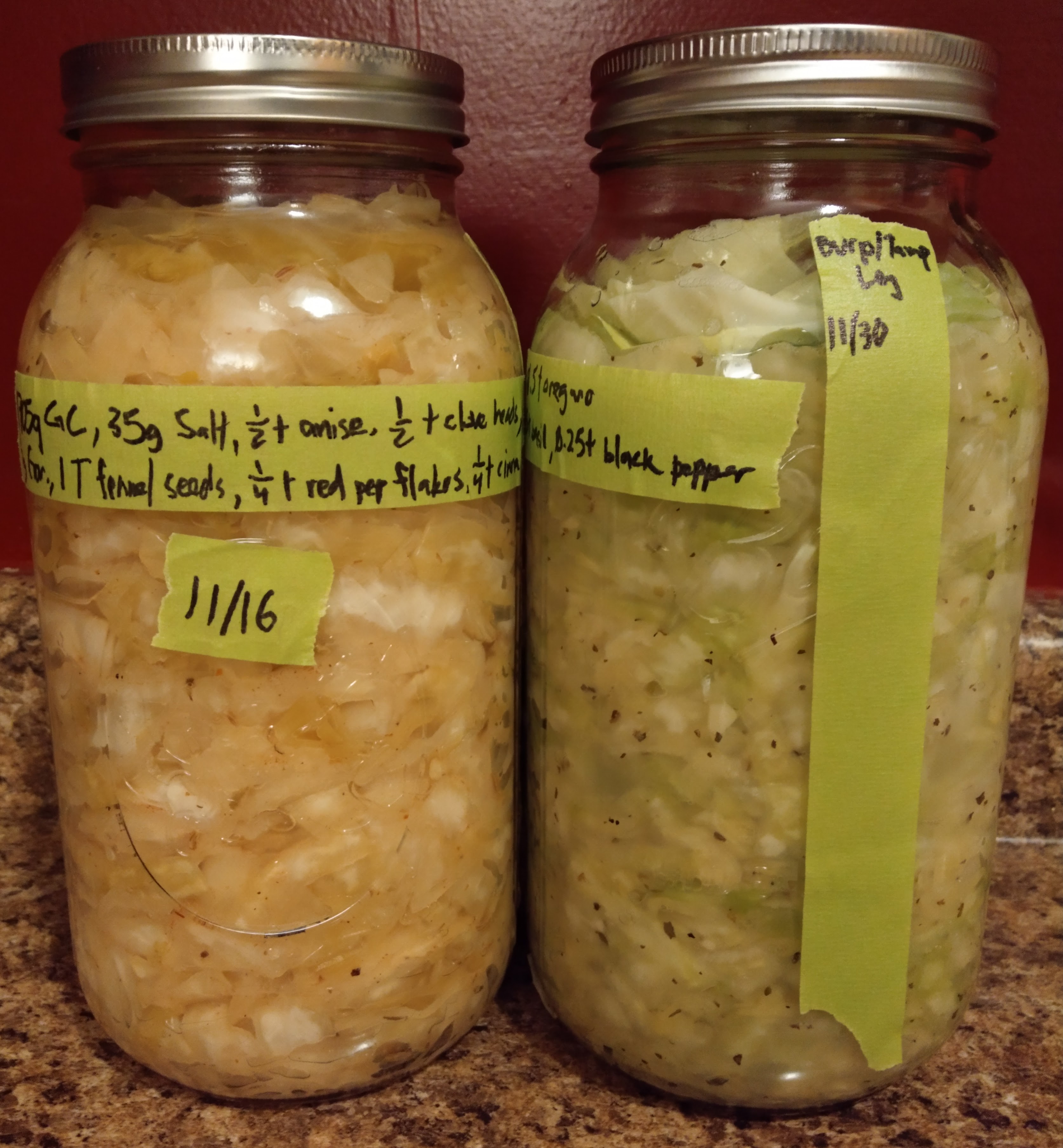Whoa! I started a ferment today. I'm really excited to see how this one turns out. I used dried basil, dried oregano, black pepper, minced garlic, and roughly chopped shallots. Read on for an unnecessarily in-depth explanation of what I did in case you would like to start your own ferment for the first time, or if you like pickles and Italian sub garnishes! There are a couple pictures for folks who like those or find those helpful.
Italian-Herbs Sauerkraut
Objects you will need:
- a very big and/or wide bowl
- a food scale *optional, see notes
- a cutting board (I use a really big one)
- a wide-mouth, 2 litre ball jar or designated fermentation crock, with an air-tight cap
- a smaller ball jar that fits inside the larger ball jar with lots of room
- masking tape or a piece of paper you won't lose, and a writing implement
- a clean dish towel that covers the ball jar from any light sources
- four pinch bowls, plates, or anything really for measuring out your ingredients
- a moderately dark place with a stable room temperature (can be cooler than room temp)
- a timer or highly visible clock
Food Items you will need (measurements I took in my batch are italicized):
- one head of green cabbage 1560 grams
- table salt 33 grams
- dried basil (fresh is great if you have it) 0.5 teaspoon--too small to measure in oz or grams
- dried oregano (fresh is great if you have it) 0.5 teaspoon--too small to measure in oz or grams
- coarsely ground black pepper (any grind is fine, I just like mine coarse) 0.25 teaspoon
- minced garlic 20 grams
- one medium, roughly chopped shallot 53 grams
Directions
First thing's first! Make sure your work space is VERY clean. We don't want to introduce any unhelpful bacteria, mold, bug eggs, or other nasties into the batch. I use strong, neutral alcohol to clean the counter, the cutting board, the knife, the work surface of the scale, the pinch bowls, and the big bowl. (I don't clean the ball jars until right before I pack the ferment--I'll explain when we get there.) You can use warm soapy water or an all-purpose cleaner instead. Once everything is clean, wash your hands. If at any point during the process you can't remember if you've washed your hands, wash them again.
Now let's prepare the cabbage. First, remove the top two to three leaves, doing your best not to rip them, and set them aside (you'll need them at the end). I balance the cabbage on its stem, and cut it into eighths. Once you have eight wedges, start shredding from the crown down to the base, making roughly similar-sized shreds. Don't bother to include the core--it won't break down. If you don't have enough space on your board to shred the whole head in one go, place your big bowl on the scale and tare it. Once you've tared it, you can start putting your cabbage in the bowl. I like to work in grams. Record the final weight of your shredded cabbage on the masking tape.

Wash your hands, and then wash your cabbage in running, cool water until you are satisfied with the color of and lack of dirt in the water. Drain the cabbage, set it aside and let it rest. At this step, you can ignore how I've flavored mine and get creative with your flavors. You can add anything you want that doesn't have added sugar or oil in it. If you're doing mine, do the rest of this paragraph; if not, skip on ahead down to the next one. Mince your garlic, measure it into a tared pinch bowl, set aside. Roughly chop your shallot, measure it into a tared pinch bowl, set aside. Measure your dried basil, dried oregano, and black pepper into the third pinch bowl and set aside. Write all of the measurements you just took on your masking tape.
Now we need to do some math! You need a ratio of 2% salt based on the weight of cabbage and any other sugary veggies in your unique mix. I simplified the equation and solved for salt for my Python SauerKrautculator program. Luckily, you don't need that program to use this formula:
(cabbage+veggies) / 49 = salt
All you have to do is plug in your "cabbage+veggies" value in whatever weight-based unit you used, and you will get back out the weight of salt that you need in that same unit. In my case, I had 1560 grams of cabbage, and 53 grams of shallots. I include the shallots in my weight measurement this time because they have more sugar than other onion-adjacents. If I plug my values into the equation, I get roughly 33 grams out:
(1560 + 53) grams/ 49 = 32.918 grams salt


So now it's time to measure the salt! Tare your last pinch bowl, and measure out the amount of salt you just calculated you need. Pour it over your cabbage. Look at what you've done. Wash your hands. Get ready. Look at the clock or set your timer for 10 minutes to start. Ready? Start punching the cabbage. I mean it. Punch it down into the bowl. Take fistfuls and squeeze them as hard as you can. Feel the salt grains. Rotate the untouched shreds from the bottom back up to the top. Squeeze, punch, squeeze. It's getting slimy, right? That's great! We need to work a lot of the moisture out of the shreds in this step. The more wilted it looks, paradoxically the crunchier the finished product will be. Has it been ten minutes? Ok, check the bottom of the bowl for how much liquid you've extracted by gently scooping away from the side. Does it seem like a lot for how much cabbage is in the bowl? If so, stop here. If not, keep beating that cabbage up for no more than 10 additional minutes. Pour your flavorings--the shallot, garlic, basil, oregano, and pepper (or your own concoction) into the cabbage and thoroughly incorporate it. Wash your raw, painful hands and drink a glass of water before the next step.
Wash your ball jars and lids with warm soapy water and place them bottoms-down on a clean surface to air dry for a couple of minutes. I save this step for last because I don't have a dishwasher so the best I can do without sterlizing them (which might hurt our good bacteria when we add the cabbage) is washing them right before I jar it all up. Set up your bowl and large ball jar for your handed-ness. I am left-handed, so I prefer to have my ball jar on my left and the bowl on my right to work towards my dominant side. If you are a righty, I suggest ball jar on right and bowl on left. Alright, so now we need to pack the cabbage mixture into the jar. After each fistful of mixture, carefully tamp it down with your fist. Keep adding the mixture until all you have left is liquid. Go ahead and pour that liquid into the jar. Remember those leaves I asked you to set aside? We're going to use them to create a barrier that keeps the cabbage mixture submerged! Rip them to the sizes you need, and pack them in with the concave side facing up (like a bowl). Once you have them packed in nicely, shove your fist in there one more time to push everything down the best you can. Look at your beautiful jar for a second--you did that with your own hands!
Now wipe the rim of the jar clean with a paper towel (or whatever form of sanitary paper you have). Fit the smaller ball jar without the lid inside of the larger one with the mouth facing up. It will have to clear the mouth of the larger ball jar. Screw the lid onto the larger jar. Put your tape label(s) on the jar. Clearly place your start date somewhere on the jar. Make yourself a Burp and Tamp Log label--this one should be pretty long. Admire your jar for a couple of minutes. Now put the towel over it and place it in its resting place. Clean up your work space for your next adventure. Or for your roommate's next adventure. Or your pet's next adventure.

Now it's all about ~maintenance~. This baby will do their best once they have achieved an anaerobic environment, or one with little oxygen. Pressure will build up in the jar and you need to release it. In order to help your baby get to anaerobic bliss, they need to be burped at least once a day. IF YOU DO NOT BURP THIS FERMENT, IT WILL EXPLODE. I burp mine and tamp the cabbage mixture down about 2-3 times a day in the first week. After the first week, if you notice that it no longer builds pressure, that's good--it's on the next stage! Now you just need to leave it be for 3-5 more weeks. The longer it sits, the more sour it gets, and I love sour so I usually let mine go for a month to a month and a half.
That's all. You did it. Thanks for sticking with me through all that! Check back over the next couple of weeks for progress pictures of the one I just made if you so desire.
*If you don't have a scale at home, that's perfectly fine! Just make sure you get a weight measurement of your cabbage where you purchase it, whether that be a store or a farmer's market. If you grew it at home or receive it as a gift but still don't have a scale, lovely and fret not! Many cabbages are roughly 2 to 2.5 pounds. If you make a single batch, many people use the ratio of 1 tablespoon of salt per 2 pounds of cabbage.